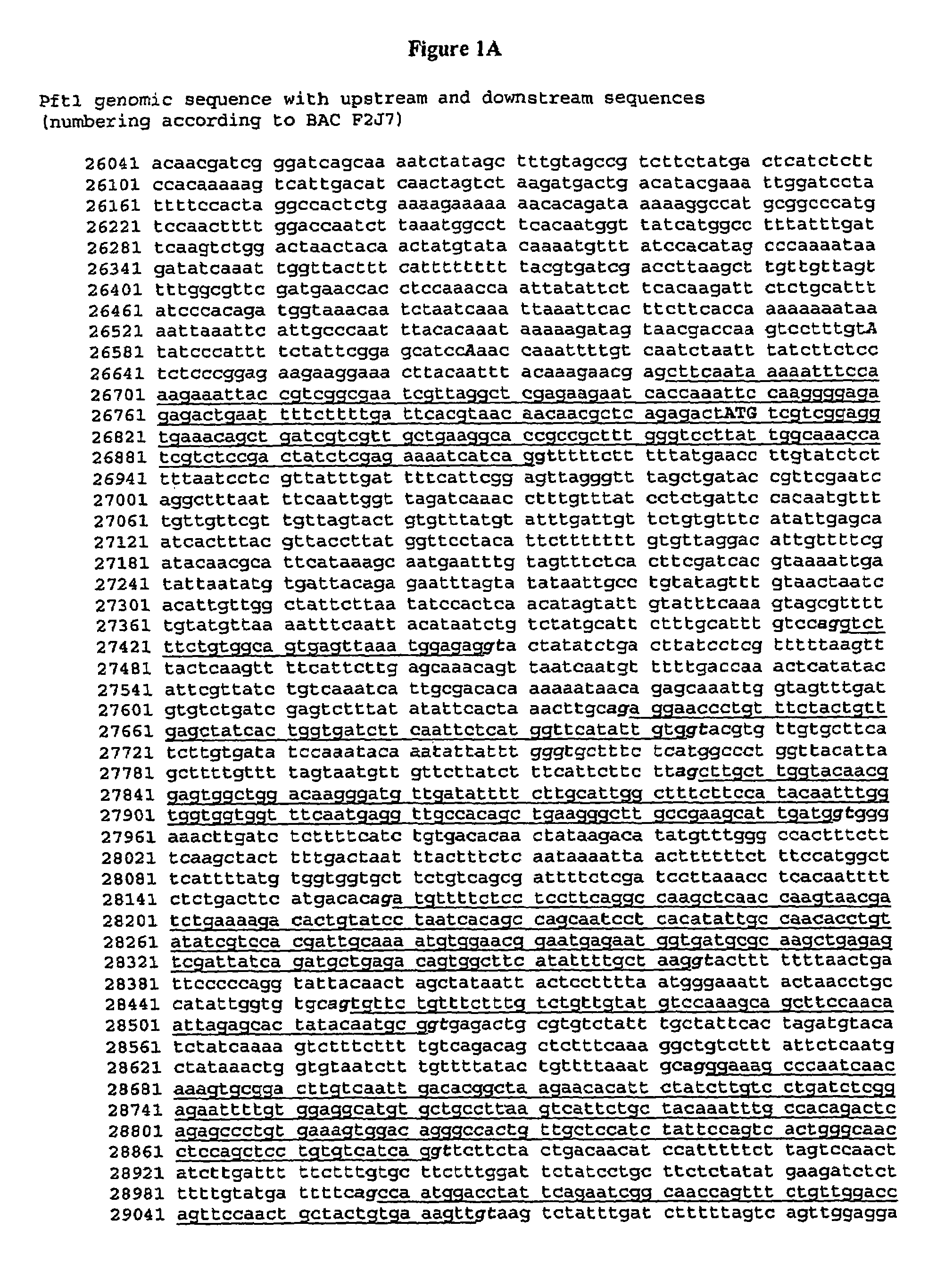Modulation of flowering time by the pft1 locus
a technology of pft1 and pft1, which is applied in the field of module of flowering time by the pft1 locus, can solve the problems of unclear assembly of signals into a signaling network, and achieve the effect of increasing flowering tim
- Summary
- Abstract
- Description
- Claims
- Application Information
AI Technical Summary
Benefits of technology
Problems solved by technology
Method used
Image
Examples
example 1
Plant Material and Growth Conditions
[0120]Except when stated otherwise, all experiments were done in the Columbia accession. The alleles for the different mutants used were phyA211 and phyB9. FT and CO overexpression lines were a gift of Detlef Weigel. Seeds were sterilized using chlorine in a vapor phase. For RNA extraction, total seedlings grown in MS media without sucrose or shoots from mature plants grown on soil were used. For hypocotyl measurements, seedlings were grown in water-agar medium. R and FR-light treatments were done in LED chambers (Percival Scientific) at 23° C. WL sources were always from fluorescent tubes, 40-70 μmol / m2 s for LD and SD respectively, except for incandescent light extensions (LI) with 2 μmol / m2 s of PAR (400-700 nm).
[0121]For the genetic screen, T-DNA activation-tagged lines were obtained from the Arabidopsis Stock Center as pools representing around 100 lines each. Each pool was plated on water agar medium, and stratified for 3 days. Germination w...
example 2
Molecular Characterization of PFT1
[0122]Genomic DNA was extracted from pft1 mutants, cut with HindIII and EcoRI for right border rescue and with BamHI and SpeI for left border rescue, ligated and electroporated into SURE competent cells (Stratagene). Genomic DNA was successfully rescued with HindIII, BamHI and SpeI restriction enzymes. Specific oligonucleotides were designed to detect by PCR the T-DNA insertion in hemizygous and homozygous lines. The following 3 primers were used in PCR:
[0123]
5′CAGAGGAACCCTGTTTCTACTGTTGAGCT3′,(SEQ ID NO: 4)5′CGTTACTTGGTTGAGCTTGGCCTGAAGGA3′(SEQ ID NO: 5)and5′TCCCGGACATGAAGCCATTTATATGTA3′.(SEQ ID NO: 6)
[0124]The expected PCR products were 563 bp for the WT and 491 bp for the mutant, while both bands were detected in hemizygotes.
[0125]The T-DNA co-segregated with the pft1 mutation in 140 chromosomes analyzed. 36 F3 populations were tested and it was noted that the Basta resistance (conferred by the T-DNA) also co-segregated with the pft1 mutation. Sout...
example 3
mRNA Quantitation
[0130]Specific mRNAs were extracted and quantified by RT-PCR, essentially as described (Blazquez, et al. Plant Physiol. 120, 1025-32 (1999)). mRNA was reverse transcribed using the 1st cDNA synthesis kit according to the manufacturer instructions (Invitrogen). Primers, annealing temperatures and the size of PCR products expected were as follows:
[0131]
(SEQ ID NO: 7)FT, 5′ GCTACAACTGGAACAACCTTTGGCAAT 3′,(SEQ ID NO: 8)5′ TATAGGCATCATCACCGTTCGTTACTC3′;63° C., 365 bp;(SEQ ID NO: 9)CO, 5′ AAACTCTTTCAGCTCCATGACCACTACT 3′,(SEQ ID NO: 10)5′ CCATGGATGAAATGTATGCGTTATGGTTA 3′,62° C.,453 bp;(SEQ ID NO: 11)UBQ10, 5′ GGTGTCAGAACTCTCCACCTCAAGAGTA 3′,(SEQ ID NO: 12)5′ TCAATTCTCTCTACCGTGATCAAGATGCA 3′,64° C., 318 bp.
[0132]In all cases at least one of the primers used for PCR spanned intron-exon junctions and amplification of genomic DNA was undetectable in non-retrotranscribed controls. PCR products were detected by southern blot using standard methodology and quantified using a phos...
PUM
| Property | Measurement | Unit |
|---|---|---|
| temperature | aaaaa | aaaaa |
| time | aaaaa | aaaaa |
| time | aaaaa | aaaaa |
Abstract
Description
Claims
Application Information
 Login to View More
Login to View More - R&D
- Intellectual Property
- Life Sciences
- Materials
- Tech Scout
- Unparalleled Data Quality
- Higher Quality Content
- 60% Fewer Hallucinations
Browse by: Latest US Patents, China's latest patents, Technical Efficacy Thesaurus, Application Domain, Technology Topic, Popular Technical Reports.
© 2025 PatSnap. All rights reserved.Legal|Privacy policy|Modern Slavery Act Transparency Statement|Sitemap|About US| Contact US: help@patsnap.com



